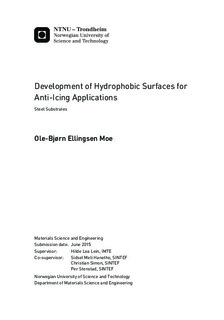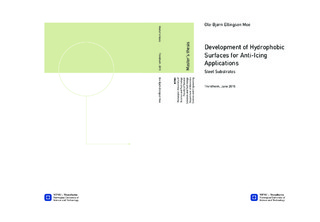| dc.description.abstract | Icing is a major problem for ships, airplanes, and wind turbines, among many other applications. To reduce or remove icing is extremely costly and is constantly in need of manpower. In this thesis the possibility of a passive resolution is investigated; a surface that reduces icing without external influence. A hydrophobic surface on steel is first developed through modification of topography and subsequent coating. Further, the icing behaviour of these hydrophobic surfaces are investigated.
The surface modification was performed by creating a hierarchical surface roughness by sand blasting and subsequent synthesis of ZnO-nanowires, a combination not found similar in literature. Samples with solely micrometric and nanometric roughness were also created in order to compare with the hierarchical roughness. Deposition of a highly hydrophobic coating layer was performed by dip-coating and vapour deposition.
When nanometric roughness was induced, dip-coating was no longer an applicable method of deposition as the coating layer was too thick and compromised the topography. Vapour deposition had no such negative effects on the topography, which resulted in superior contact angle values.
Superhydrophobic contact angle values (> 150$\degree$) were achieved for all samples where roughness was induced. The superior hydrophobic behaviour was observed on the sample with hierarchical roughness, with a contact angle of 164 +/- 1.54 degrees. Upon measuring the contact angle hysteresis, superhydrophobic behaviour was not observed. The hierarchical sample showed a hysteresis value of approximately 80 degrees. The sample with superior hysteresis values was the sand blasted sample, with a value of 37 degrees. These values suggest poor performance regarding icephobicity, as hysteresis values near zero are desired.
During the icing experiments, all samples showed the same behaviour with no definite prevention of crystallisation. Upon deicing the ice melted and slid off of all samples within 6 minutes, except the hierarchical sample where the water seemed to adhere more strongly, leaving the sample wet for a longer period of time.
These observations lead to the hypothesis that the ZnO-nanowires promote an undesirable state of wetting, Wenzel wetting, which would increase the adhesion of water significantly, causing large hysteresis values and no slide-off behaviour. The hysteresis value measured on the sand blasted sample is however also too high. This may be due to misalignments of the hydrophobic molecules deposited on the surface.
In order to achieve hydrophobic surfaces with anti-icing properties, the sole development of hierarchical roughness is thus not enough. The dimensions of both the micrometric and nanometric structures must be within the range of achieving the desired Cassie-Baxter wetting state, and resist a subsequent transition to the Wenzel state. This may be achieved by an increase in ZnO-nanowire density and height, along with a decrease of the diameters. In addition, the coating needs investigation to ensure the correct alignment of the hydrophobic molecules. | |

